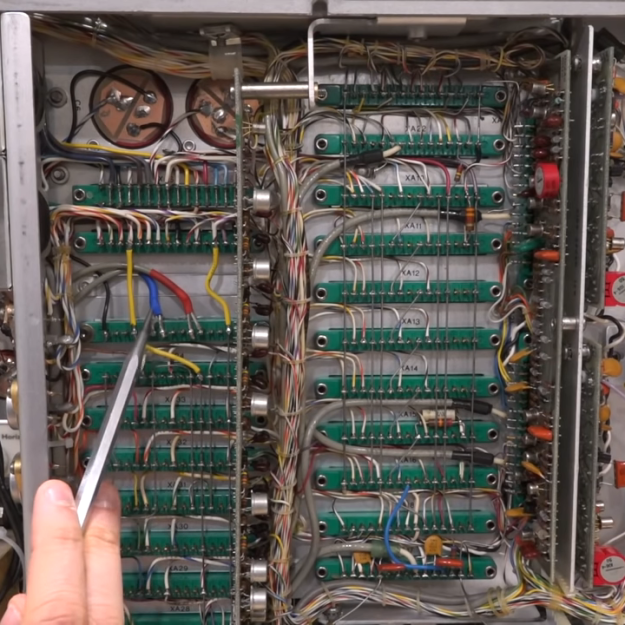Notice: no vintage Hewlett Packard test equipment was harmed in the making of this overly complicated Nixie clock. In fact, if anything, the HP 5245L electronic counter came out better off than it went into the project.

We mention the fate of this instrument mainly because we’ve seen our fair share of cool-looking-old-thing-gutted-and-filled-with-Arduinos projects before, and while they can be interesting, there’s something deeply disturbing about losing another bit of our shared electronic heritage. To gut this device, which hails from the early 1960s and features some of the most beautiful point-to-point backplane wiring we’ve ever seen, would have been a tragedy, one that [Shahriar] wisely avoided.
After a bit of recapping and some power supply troubleshooting, the video below treats us to a tour of the Nixie-based beauty. It’s a wonderful piece, and still quite accurate after all these decades, although it did need a bit of calibration. Turning it into a clock non-destructively required adding a little bit of gear, though. Internally, [Shahriar] added a divide-by-ten card to allow the counter to use an external 10-MHz reference. Externally, an ERASynth++ programmable signal generator was used to send a signal to the counter from 0 Hz to 23,595.9 kHz, ramping up by 100 Hz every second.
The end result is the world’s most complicated 24-hour clock, which honestly wasn’t even the point of the build at all. It was to show off the glorious insides of the counter, introduce us to some cool new RF tools, and as always with [Shahriar]’s videos, to educate and inform. We’ve always enjoyed his wizardry, from his look into automotive radars to a million-dollar scope teardown, and this was another great project.















I love the look and design of the old HP test equipment.
I have an HP 5326 DVM/Counter that I toyed with to make a clock like this (desperately need to change the fan to fix the bearing whine).
I completely agree too, it is a shame to destroy old equipment like this just for the displays. :/
Especially since you can get absurdly detailed service manuals to fix just about anything you would come across.
I’ve replaced a lot of fans on old HP equipment. Sometimes it’s adequate to add a thick gear lubricant to the bearing: you may get another 10 years out of the same fan, depending on how much you use it.
Yes, it gives me a warm feeling to see it back in action, and as a nice clock.
Although I think a more complicated clock is an HP cesium standard.
B^)
I had this same model of HP counter, and as far as I could test it was accurate to +/- 10 Hz on a 10 MHz signal! Maybe mine was unusual, but I don’t think so. HP equipment of that era was some of the best test equipment on the planet.
I’m glad he didn’t damage that lovely old counter, they literally don’t make them like that anymore.
Excellent lab work and presentation.
Will appeal to those who want to work with and any form of instrumentation and/or measurement.
Taking every piece apart and analysis of schematics is great.
Nice work! It shows how the day’s pace gets faster and faster until you reach the end.
HP used to be the platinum standard in test equipment. This device is representative.
My low-tech version using voltage rather than frequency!
https://hackaday.io/project/169042-nixie-voltmeter-clock
“0 Hz to 23,595.9 kHz, ramping up by 100 Hz every second” well not _every_ second, sometimes it’s 3.9kHz? and then there’s the hours….
Here is a similar clock I built, with a similar counter.
But much simpler:
https://hackaday.io/project/176326-intuitive-counter-clock
I like that approach too!
Nice!
I noticed that he changed plug-ins during the video.
I’d love to know, when that’s set on the scale to show 1Hz resolution, and in that showing-the-count mode, and you feed it an input signal of 10MHz, does that last digit actually cycle at that rate? How fast can a neon glow discharge turn on and off, anyway?
Nice to see a beautiful piece of workmanship like that being treated with respect and implemented non-destructively! This is truly awesome.
I have a nixie frequency counter of this vintage, an HP 5326C. It worked 25+ years ago, but I don’t dare turn it on now. Can anyone advise me on how to tackle recapping this? The online service manual is almost too extensive, with a troubleshooting and repair section, parts list, etc., but it does not exactly speak to the “technical archeologist” 50 years later. Could I buy a high voltage power supply and bypass the one that’s there?